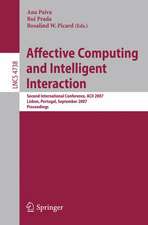Managing Distributed Dynamic Systems with Spatial Grasp Technology: Studies in Computational Intelligence, cartea 690
Autor Peter Simon Sapatyen Limba Engleză Paperback – 13 iul 2018
| Toate formatele și edițiile | Preț | Express |
|---|---|---|
| Paperback (1) | 634.91 lei 43-57 zile | |
| Springer International Publishing – 13 iul 2018 | 634.91 lei 43-57 zile | |
| Hardback (1) | 641.24 lei 43-57 zile | |
| Springer International Publishing – 22 feb 2017 | 641.24 lei 43-57 zile |
Din seria Studies in Computational Intelligence
- 50%
 Preț: 264.48 lei
Preț: 264.48 lei - 20%
 Preț: 1138.71 lei
Preț: 1138.71 lei - 20%
 Preț: 970.01 lei
Preț: 970.01 lei - 20%
 Preț: 1428.22 lei
Preț: 1428.22 lei - 20%
 Preț: 168.78 lei
Preț: 168.78 lei - 18%
 Preț: 1093.52 lei
Preț: 1093.52 lei - 20%
 Preț: 565.38 lei
Preț: 565.38 lei - 20%
 Preț: 638.34 lei
Preț: 638.34 lei - 20%
 Preț: 1030.03 lei
Preț: 1030.03 lei - 20%
 Preț: 1552.26 lei
Preț: 1552.26 lei - 20%
 Preț: 632.66 lei
Preț: 632.66 lei - 20%
 Preț: 646.41 lei
Preț: 646.41 lei - 20%
 Preț: 976.52 lei
Preț: 976.52 lei - 20%
 Preț: 974.09 lei
Preț: 974.09 lei - 20%
 Preț: 973.27 lei
Preț: 973.27 lei - 20%
 Preț: 1146.00 lei
Preț: 1146.00 lei - 20%
 Preț: 1420.10 lei
Preț: 1420.10 lei - 20%
 Preț: 1024.36 lei
Preț: 1024.36 lei - 20%
 Preț: 1030.03 lei
Preț: 1030.03 lei - 20%
 Preț: 1028.39 lei
Preț: 1028.39 lei - 18%
 Preț: 2458.20 lei
Preț: 2458.20 lei - 20%
 Preț: 972.45 lei
Preț: 972.45 lei - 20%
 Preț: 1146.00 lei
Preț: 1146.00 lei - 20%
 Preț: 1144.40 lei
Preț: 1144.40 lei - 20%
 Preț: 1025.17 lei
Preț: 1025.17 lei - 20%
 Preț: 1435.50 lei
Preț: 1435.50 lei - 18%
 Preț: 1379.82 lei
Preț: 1379.82 lei - 18%
 Preț: 1105.93 lei
Preț: 1105.93 lei - 20%
 Preț: 1021.92 lei
Preț: 1021.92 lei - 20%
 Preț: 991.11 lei
Preț: 991.11 lei - 20%
 Preț: 1027.60 lei
Preț: 1027.60 lei - 20%
 Preț: 1253.88 lei
Preț: 1253.88 lei - 20%
 Preț: 1022.74 lei
Preț: 1022.74 lei - 20%
 Preț: 971.65 lei
Preț: 971.65 lei - 20%
 Preț: 1150.03 lei
Preț: 1150.03 lei - 20%
 Preț: 1142.76 lei
Preț: 1142.76 lei - 20%
 Preț: 1041.37 lei
Preț: 1041.37 lei - 20%
 Preț: 1144.40 lei
Preț: 1144.40 lei - 20%
 Preț: 1146.83 lei
Preț: 1146.83 lei - 20%
 Preț: 1434.72 lei
Preț: 1434.72 lei - 18%
 Preț: 988.76 lei
Preț: 988.76 lei - 20%
 Preț: 980.55 lei
Preț: 980.55 lei - 20%
 Preț: 1038.11 lei
Preț: 1038.11 lei - 20%
 Preț: 1262.78 lei
Preț: 1262.78 lei - 20%
 Preț: 977.30 lei
Preț: 977.30 lei - 20%
 Preț: 1031.01 lei
Preț: 1031.01 lei - 20%
 Preț: 927.84 lei
Preț: 927.84 lei - 20%
 Preț: 1153.30 lei
Preț: 1153.30 lei - 20%
 Preț: 1433.08 lei
Preț: 1433.08 lei - 20%
 Preț: 1027.60 lei
Preț: 1027.60 lei
Preț: 634.91 lei
Preț vechi: 793.64 lei
-20% Nou
Puncte Express: 952
Preț estimativ în valută:
121.55€ • 125.00$ • 100.83£
121.55€ • 125.00$ • 100.83£
Carte tipărită la comandă
Livrare economică 17 februarie-03 martie
Preluare comenzi: 021 569.72.76
Specificații
ISBN-13: 9783319844053
ISBN-10: 3319844059
Ilustrații: XVII, 284 p. 215 illus., 167 illus. in color.
Dimensiuni: 155 x 235 mm
Greutate: 0.43 kg
Ediția:Softcover reprint of the original 1st ed. 2017
Editura: Springer International Publishing
Colecția Springer
Seria Studies in Computational Intelligence
Locul publicării:Cham, Switzerland
ISBN-10: 3319844059
Ilustrații: XVII, 284 p. 215 illus., 167 illus. in color.
Dimensiuni: 155 x 235 mm
Greutate: 0.43 kg
Ediția:Softcover reprint of the original 1st ed. 2017
Editura: Springer International Publishing
Colecția Springer
Seria Studies in Computational Intelligence
Locul publicării:Cham, Switzerland
Cuprins
Chapter 1 Introduction.- Chapter 2 Some Theoretical Background.- Chapter 3 Spatial Grasp Model.- Chapter 4 SGL Detailed Specification.- Chapter 5 Main Spatial Mechanisms in SGL.- Chapter 6 SGL Networked Interpreter.- Chapter 7 Creation, Activation and Management of a Distributed World.- Chapter 8 Parallel and Distributed Network Operations.- Chapter 9 Solving Social Problems.- Chapter 10 Automated Command and Control.- Chapter 11 Collective Robotics.- Chapter 12 Conclusions.
Textul de pe ultima copertă
The book describes a novel ideology and supporting information technology for integral management of both civil and defence-orientated large, distributed dynamic systems. The approach is based on a high-level Spatial Grasp Language, SGL, expressing solutions in physical, virtual, executive and combined environments in the form of active self-evolving and self-propagating patterns spatially matching the systems to be created, modified and controlled. The communicating interpreters of SGL can be installed in key system points, which may be in large numbers (up to millions and billions) and represent equipped humans, robots, laptops, smartphones, smart sensors, etc. Operating under gestalt-inspired scenarios in SGL initially injected from any points, these systems can be effectively converted into goal-driven spatial machines (rather than computers asdealing with physical matter too) capable of responding to numerous challenges caused by growing world dynamics in the 21st century. Including numerous practical examples, the book is a valuable resource for system managers and programmers.
Caracteristici
Cultivates a holistic vision of large distributed dynamic systems Includes a new language for combined solutions in physical and virtual worlds Offers guidance for quick reactions to changing goals and environments Supports unified transition to distributed unmanned systems Provides sufficient details for technology implementation on any platform Includes supplementary material: sn.pub/extras





























